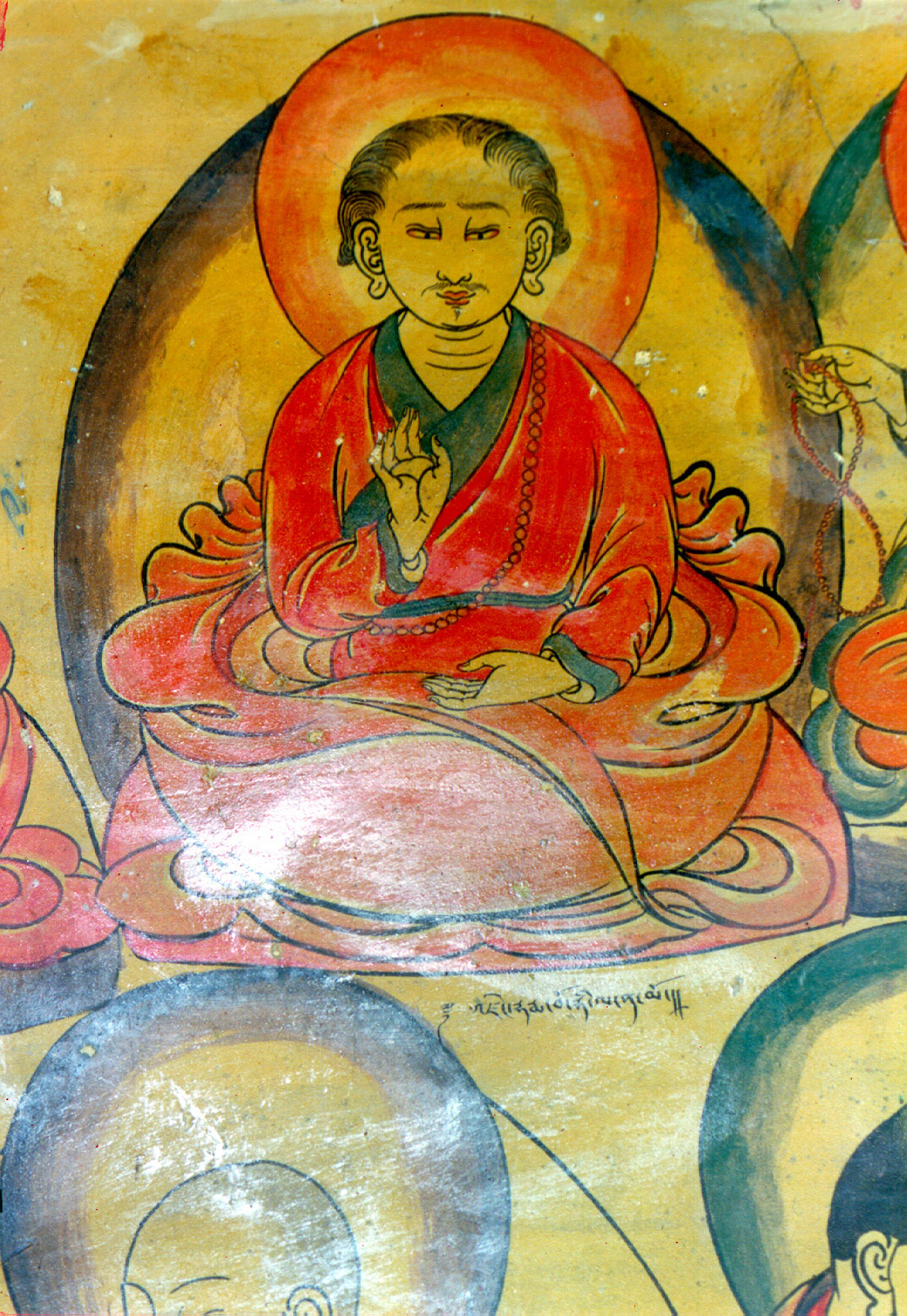|
Semde
Semde (; Sanskrit: , "mind division", "mind class" or "mind series" is the name of one of three scriptural and lineage (Buddhism), lineage divisions within the Dzogchen (Great Perfection) tradition. The Nyingma school of Tibetan Buddhism traditionally classifies its Dzogchen teaching into three main divisions: Semde, Longdé (Space Series) and Menngagde (Secret Instruction Series). Semde texts are mostly said to be translations by figures of History of Tibetan Buddhism#First dissemination (7th–9th centuries), the early transmission (7th–9th centuries) of Buddhism to Tibet like Sri Singha, Śrī Siṅgha, Vairotsana and Vimalamitra. These texts emphasize the "awakened mind" (Tibetan: ''byang-chub-kyi sems'', Skt. ''bodhicitta''), which is the true nature of the mind and is essentially pure and perfect, just like Buddhahood. Semde texts critique tantric practice as being based on effort, and instead promote simple and effortless contemplation of the mind and its Emptiness (Buddhi ... [...More Info...] [...Related Items...] OR: [Wikipedia] [Google] [Baidu] |
Dzogchen
Dzogchen ( 'Great Completion' or 'Great Perfection'), also known as ''atiyoga'' ( utmost yoga), is a tradition of teachings in Indo-Tibetan Buddhism and Bön aimed at discovering and continuing in the ultimate ground of existence. The goal of Dzogchen is the direct experience of this basis, called (Sanskrit: ). There are spiritual practices taught in various Dzogchen systems for discovering . Dzogchen emerged during the first dissemination of Buddhism in Tibet, around the 7th to 9th centuries CE. While it is considered a Tibetan development by some scholars, it draws upon key ideas from Indian sources. The earliest Dzogchen texts appeared in the 9th century, attributed to Indian masters. These texts, known as the Eighteen Great Scriptures, form the "Mind Series" and are attributed to figures like Śrī Siṅgha and Vimalamitra. Early Dzogchen was marked by a departure from normative Vajrayāna practices, focusing instead on simple calming contemplations leading to a di ... [...More Info...] [...Related Items...] OR: [Wikipedia] [Google] [Baidu] |
Nyingma
Nyingma (, ), also referred to as ''Ngangyur'' (, ), is the oldest of the four major schools of Tibetan Buddhism. The Nyingma school was founded by PadmasambhavaClaude Arpi, ''A Glimpse of the History of Tibet'', Dharamsala: Tibet Museum, 2013. as the first translations of Buddhist scriptures from Pali and Sanskrit into Tibetic languages, Tibetan occurred in the eighth century. The establishment of Tibetan Buddhism and the Nyingma tradition is collectively ascribed to Khenpo Shantarakshita, Guru Padmasambhava, and King Trisong Detsen, known as ''Khen Lop Chos Sum'' (The Three: Khenpo, Lopon, Chosgyal). The Nyingma tradition traces its Dzogchen lineage from the Adi-Buddha, first Buddha Samantabhadra to Garab Dorje, and its other lineages from Indian mahasiddhas such as Sri Singha and Jnanasutra. Yeshe Tsogyal recorded the teachings. Other great masters from the founding period include Vimalamitra, Vairotsana, and Buddhaguhya. The Nyingma tradition was physically founded at Samye ... [...More Info...] [...Related Items...] OR: [Wikipedia] [Google] [Baidu] |
Longdé
Longdé (, ) is the name of one of three scriptural divisions within Dzogchen, which is itself the pinnacle of the Yana (Buddhism)#The nine yanas, ninefold division of practice according to the Nyingma school of Tibetan Buddhism. The name "longdé" is translated as "Space Division" or "Space Series" of Dzogchen and emphasises the emptiness () or spaciousness () aspect of the Natural State. Due to the different approaches of various Dzogchen lineages, three series of teachings have developed, of which longdé is one. The other two divisions or series are semde and menngagde. Penor Rinpoche attributes longdé to Dorje Zampa, Sri Singha and Vairotsana's lineage. History The series of Space reflects the developments of the 11th–14th centuries and emphasizes "space" or "expanse" (''klong''). According to Sten Anspal this class of texts "is difficult to define or characterize uniformly" and "were not unified into a single system". Because of this, it has been seen either as nearl ... [...More Info...] [...Related Items...] OR: [Wikipedia] [Google] [Baidu] |
Menngagde
In Tibetan Buddhism and Bon, Menngagde (, ), is the name of one of three scriptural and lineage divisions within Dzogchen (''Great Perfection'' ). Dzogchen is itself the pinnacle of the ninefold division of practice according to the Nyingma school of Tibetan Buddhism. Menngagde focuses on rigpa. The Menngagde or 'Instruction Class' of Dzogchen teachings are divided into two parts: ''trekchö'' and ''tögel''. Practice For general purposes, Menngagde may also be known as Nyingthik. Germano & Gyatso (2000: p. 240) note a similarity of practice between Chan-like formless meditations and Nyingthik/Menngagde: In the Dzogchen textual tradition Traditionally, Mañjuśrīmitra () is said to have classified all the Dzogchen teachings transmitted by his teacher, Garab Dorje, into three series: semdé (), Longdé (), and menngagdé. Mañjuśrīmitra's student Sri Singha reedited the oral instruction cycle and in this form the teaching was transmitted to Jñānasūtra and Vimal ... [...More Info...] [...Related Items...] OR: [Wikipedia] [Google] [Baidu] |
Classes Of Tantra In Tibetan Buddhism
Classes of Tantra in Tibetan Buddhism refers to the categorization of Buddhist tantric scriptures in Indo-Tibetan Buddhism. Tibetan Buddhism inherited numerous tantras and forms of tantric practice from medieval Indian Buddhist Tantra. There were various ways of categorizing these tantras in India. In Tibet, the Sarma (New Translation) schools categorize tantric scriptures into four classes, while the Nyingma (Ancients) school use six classes of tantra. Sarma ("New Translation") classification The Sarma, "New Translation" schools of Tibetan Buddhism (Gelug, Sakya, Kagyu, Jonang) classify tantric practices and texts into four classes. In this, they follow Indian Tantric Buddhists such as Abhayākara, who makes this distinction in his ''Clusters of Quintessential Instructions''. Tantras are classified according to the capacity of persons, the deities they use, the specific types of methods they employ and how they use desire (''kama'').Tsong-kha-pa, ''The Great Exposition of ... [...More Info...] [...Related Items...] OR: [Wikipedia] [Google] [Baidu] |
Garab Dorje
Garab Dorje (c. 665) () was the first human to receive the complete direct transmission teachings of Sutra, Tantra and Dzogchen. The circumstances of his birth are shrouded in different interpretations, with some accounts describing a miraculous birth by a virgin daughter of the king of Uddiyana. Garab Dorje became the first teacher of Dzogchen ("Great Perfection", also called ''Ati Yoga'') teachings. Garab Dorje's core teachings revolve around understanding the nature of the mind as the original Buddha, beyond birth and cessation, emphasizing meditation as a practice of allowing this natural state without seeking, this is the highest teaching in Buddhism. According to the Nyingma school tradition of Tibetan Buddhism Tibetan Buddhism is a form of Buddhism practiced in Tibet, Bhutan and Mongolia. It also has a sizable number of adherents in the areas surrounding the Himalayas, including the Indian regions of Ladakh, Gorkhaland Territorial Administration, D ..., he transmit ... [...More Info...] [...Related Items...] OR: [Wikipedia] [Google] [Baidu] |
Yogachara
Yogachara (, IAST: ') is an influential tradition of Buddhist philosophy and psychology emphasizing the study of cognition, perception, and consciousness through the interior lens of meditation, as well as philosophical reasoning (hetuvidyā). Yogachara was one of the two most influential traditions of Mahayana, Mahayana Buddhism in India, along with Madhyamaka. The compound ''Yogācāra'' literally means "practice of yoga", or "one whose practice is yoga", hence the name of the school is literally "the school of the yogins". Yogācāra was also variously termed ''Vijñānavāda'' (the doctrine of consciousness), ''Vijñaptivāda'' (the doctrine of ideas or percepts) or ''Vijñaptimātratā-vāda'' (the doctrine of 'mere representation'), which is also the name given to its major theory of mind which seeks to deconstruct how we perceive the world. There are several interpretations of this main theory: various forms of Idealism, as well as a Phenomenology (philosophy), phenomen ... [...More Info...] [...Related Items...] OR: [Wikipedia] [Google] [Baidu] |
Buddha-nature
In Buddhist philosophy and soteriology, Buddha-nature ( Chinese: , Japanese: , , Sanskrit: ) is the innate potential for all sentient beings to become a Buddha or the fact that all sentient beings already have a pure Buddha-essence within themselves.Heng-Ching ShihThe Significance Of 'Tathagatagarbha' – A Positive Expression Of 'Sunyata'/ref> "Buddha-nature" is the common English translation for several related Mahāyāna Buddhism, Buddhist terms, most notably ''tathāgatagarbha'' and ''buddhadhātu'', but also ''sugatagarbha,'' and ''buddhagarbha''. ''Tathāgatagarbha'' can mean "the womb" or "embryo" (''garbha'') of the "thus-gone one" (''Tathagata, tathāgata''), and can also mean "containing a ''tathāgata''"''. Buddhadhātu'' can mean "buddha-element", "buddha-realm", or "buddha-substrate". Buddha-nature has a wide range of (sometimes conflicting) meanings in Indian Buddhism and later in East Asian Buddhism, East Asian and Tibetan Buddhism, Tibetan Buddhist literatur ... [...More Info...] [...Related Items...] OR: [Wikipedia] [Google] [Baidu] |
Tibetan Script
The Tibetan script is a segmental writing system, or '' abugida'', forming a part of the Brahmic scripts, and used to write certain Tibetic languages, including Tibetan, Dzongkha, Sikkimese, Ladakhi, Jirel and Balti. Its exact origins are a subject of research but is traditionally considered to be developed by Thonmi Sambhota for King Songtsen Gampo. The printed form is called uchen script while the hand-written form used in everyday writing is called umê script. This writing system is especially used across the Himalayan Region. History Little is known about the exact origins of Tibetan script. According to Tibetan historiography, it was developed during the reign of King Songtsen Gampo by his minister Thonmi Sambhota, who was sent to India along with other scholars to study Buddhism along with Sanskrit and other brahmi languages. They developed the Tibetan script from the Gupta script while at the Pabonka Hermitage. This occurred , towards the beginning of ... [...More Info...] [...Related Items...] OR: [Wikipedia] [Google] [Baidu] |
Samten Karmay
Samten Gyeltsen Karmay () (1936-) is a writer and researcher in the field of Tibetan Studies. His work is focused on the study of Tibetan myths, beliefs, the Bon religion and religious history. Life and work Samten Gyeltsen was born in 1936 in Amdo Sharkhog, eastern Tibet. He received religious training in Dzogchen meditation from his uncle. He completed his studies in the Bon monastery in 1955, obtaining the degree of geshe, and left with a group of friends to Drepung Monastery, a Gelug gompa near Lhasa. The monastery was known for its high philosophical training. After leaving Drepung due to the difficult political situation, Samten moved to Nepal and later to India. After working for some time in Delhi, he was invited to England by David Snellgrove under a Rockefeller fellowship. Upon moving to Europe, he assumed the surname Karmay. He studied under two mentors, Snellgrove and Rolf Stein, who both recognized Samten's knowledge of Tibetan texts. He earned an M. Phil degree at ... [...More Info...] [...Related Items...] OR: [Wikipedia] [Google] [Baidu] |
Kashmir Shaivism
Kashmir Shaivism tradition is a 20th century umbrella-term for a body of Sanskrit learning, Sanskrit exegetical literature from several Nondualism, non-dualist Shaivism, Shaiva-Shaktism, Shakta Tantra, tantric and Monism, monistic religious traditions, often used synonymously for the Trika-school or the "Philosophy of Recognition" (''Pratyabhijna, Pratyabhijnad''). These traditions originated in Kashmir after 850 CE, as an Sanskritization, adaptation to upper-class Hindu norms of 'wild' tantric Kaula (Hinduism), Kaula traditions. Trika Shaivism later spread beyond Kashmir, particularly flourishing in the states of Odisha and Maharashtra. Defining features of the Trika tradition are its Idealism, idealistic and Monism, monistic ''pratyabhijna'' ("direct knowledge of one's self," "recognition") philosophical system, propounded by Utpaladeva (c. 925–975 CE) and Abhinavagupta (c. 975–1025 CE), and the use of several triades in its philosophy, including the three goddesses Par ... [...More Info...] [...Related Items...] OR: [Wikipedia] [Google] [Baidu] |








